1. Mobile Devices Make AR Accessible
One of the main reasons that mobile devices are better suited for AR than traditional desktop computers is that they are portable and easily accessible. People can use their mobile devices to explore AR content in real-time, wherever they are. This makes it easy for users to engage with AR applications and try out new features without committing to a long-term investment.
2. Mobile Devices Have Cameras
Mobile devices have cameras that can be used to capture the physical world around us. This is essential for creating an immersive AR experience. By using the camera, AR apps can superimpose digital content onto the real-world environment. This allows users to interact with the virtual objects in a more natural and intuitive way.
3. Mobile Devices Have Accelerometers
Mobile devices have accelerometers that can detect changes in movement. This is particularly useful for AR apps that require users to move their devices to experience the content. For example, an AR game that requires users to dodge obstacles will be more engaging on a mobile device than on a desktop computer because the user can physically duck and dodge the virtual objects.
4. Mobile Devices Have GPS
Mobile devices have GPS capabilities that allow them to determine the user’s location. This is particularly useful for AR apps that are designed to be used outdoors. By using the user’s location, AR apps can provide contextual information and create a more personalized experience for users.
5. Mobile Devices Have Large User Base
Mobile devices have a large user base, with billions of people worldwide owning a smartphone. This means that there is a huge potential market for AR applications. By targeting mobile devices, AR developers can reach a wider audience and increase the adoption rates of their apps.
6. Mobile Devices Support Multiple Operating Systems
Mobile devices support multiple operating systems, including iOS and Android. This means that AR developers can create apps that are compatible with a wide range of devices, making it easier for users to access and use the app.
7. Mobile Devices Have Improved Hardware
In recent years, mobile device hardware has improved significantly, with many models now featuring high-resolution displays, powerful processors, and large amounts of memory. This makes it possible to create AR apps that are visually stunning and offer a smooth user experience.
8. Mobile Devices Have Increased User Engagement
Mobile devices have increased user engagement, with people spending more time on their phones than ever before. This means that there is a captive audience for AR applications, providing an opportunity for developers to reach new users and increase the adoption rates of their apps.
Case Studies:
1. Pokémon Go
Pokémon Go is one of the most popular AR games in history, with millions of people worldwide playing the game. The game’s success can be attributed to several factors, including its accessibility on mobile devices and its ability to tap into existing fan bases. By leveraging the power of mobile devices, Pokémon Go was able to create an immersive and engaging experience for users.
2. IKEA Place
IKEA Place is an AR app that allows users to visualize furniture in their homes before making a purchase. The app’s success can be attributed to its ability to provide value to users by helping them make informed purchasing decisions. By using mobile devices, IKEA Place was able to create a personalized and interactive experience for users, increasing the likelihood of adoption.
Conclusion:
In conclusion, mobile phones boost the adoption rates of AR applications because they are portable, have cameras and accelerometers, support GPS, have a large user base, support multiple operating systems, have improved hardware capabilities, and increase user engagement. By leveraging the power of mobile devices for AR, developers can create engaging and immersive experiences that resonate with their target audience. As AR technology continues to evolve, we can expect to see even more innovative and exciting applications emerge in the future.
FAQs:
1. What is augmented reality?
Augmented Reality (AR) is a technology that overlays digital content onto the real world, allowing users to interact with virtual objects in a more natural and intuitive way. AR has found success in various industries such as gaming, advertising, and education.
2. How does augmented reality work on mobile devices?

AR works on mobile devices by using the camera to capture the physical world around us and then overlaying digital content onto that environment. This allows users to interact with virtual objects in a more natural and intuitive way.
3. What are some benefits of using mobile devices for augmented reality applications?
Some benefits of using mobile devices for AR include portability, accessibility, increased engagement, improved hardware capabilities, and the ability to reach a wider audience through multiple operating systems.
4. What are some examples of successful AR applications?
Examples of successful AR applications include Pokémon Go, IKEA Place, and Snapchat’s augmented reality filters.
5. How can AR developers create engaging and immersive experiences?
AR developers can create engaging and immersive experiences by leveraging the power of mobile devices, creating personalized and interactive content, providing value to users, and continuously evolving and improving the technology.
